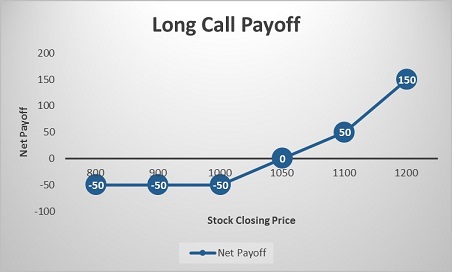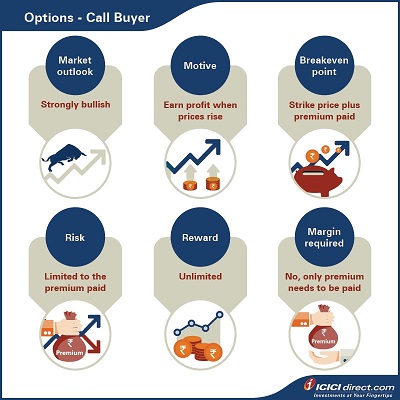Learning Modules Hide
Hide
Chapter 4: Options Trading – Long Call (Call Buyer)
Rajeev often gets confused. There is a section on a business television channel that promises Options strategies. However, he often feels more confused when he is unable to make sense of the advice give out by experts. He is contemplating signing up for a course to understand terms so that he can make sense of the expert advice and use it. Rajeev is not alone.
We know going long on an Option means to buy it while going short on it means to sell the Option. But going long on a Put Option and going long on a Call Option carry different connotations. Confused? Don’t worry, we’ll clear that up in this chapter.
Call and Put Options trade positions
As we know, there are two kinds of Options available in the derivatives market – Call Options and Put Options.
A Call Option is the right, not the obligation, to buy an underlying asset at an agreed price on a particular date.
A Put Option is the right, not the obligation, to sell an underlying asset at an agreed price on a particular date.
- Going long on Call Options makes you a buyer of that Option. It means that long Call Option gives you the right to buy an underlying asset but not an obligation. Going long or buying a Call Option means the buyer will have to pay an Option premium to the seller of the Option. The seller here is going short on the Call Option. The seller has to sell if the buyer exercises their right.
- Put Option gives the buyer of the Option the right to sell, not the obligation, the underlying asset. Here, the buyer is going long on the Put Option by paying an Option premium to the seller, i.e. the party going short on the Option.
|
Did you know? The Options premium changes with fluctuation in price. The profit and loss in the Option are equal to the difference between the premium paid and premium received. |
Now, let’s understand each of the Option positions in detail:
Long Call
A long Call position is useful when you are strongly bullish about the underlying stock or index. You expect a huge upside rally in the stock before the expiry of a contract.
Let’s understand this with an example.
Assume that you have purchased ABC Ltd.’s Rs. 1,000 Call Option at a premium of Rs. 50. It means that you have purchased the right to buy ABC at Rs. 1,000 on expiry and have paid Rs. 50 to the seller of the Option. In other words, you may buy ABC Ltd. at Rs. 1,000 on the expiry of the contract. You may prefer to buy if the market price is favorable to you i.e. if the price is more than Rs. 1000.
Let us look at three scenarios within this:
Scenario 1: ABC closes at Rs. 1,200 on expiry
In this case, exercising your Call Option will be profitable to you. You could purchase ABC at Rs. 1,000 per unit. Even after paying Rs. 50 as Option premium, you make a net profit of Rs. 150.
- Please note that Rs. 50, paid to the seller, is the upfront cost. Your breakeven point, in this case, would be Rs. 1,000 + Rs. 50 = Rs. 1,050.
Alternatively, we can also calculate the premium paid and premium received as follows:
Premium paid = Rs. 50
Premium received on expiry (equal to intrinsic value) = Max {0, (Spot price – Strike price)} = Max {0, (1200 – 1000)} = Max (0, 200) = Rs. 200
Net profit/loss = Premium received – Premium paid = 200 – 50 = Rs. 150
Scenario 2: ABC closes at Rs. 800 on expiry
In this case, it would make sense not to exercise your Call Option. You will lose the premium paid i.e. Rs. 50. However, the loss in the long Option position in this case is not more than the premium paid.
Alternatively, we can also calculate the premium paid and premium received.
Premium paid = Rs. 50
Premium received on expiry (equal to intrinsic value) = Max {0, (Spot price – Strike price)}
= Max {0, (800 – 1000)} = Max (0, – 200) = 0
Net profit/loss = Premium received – Premium paid = 0 – 50 = – Rs. 50 i.e. loss of Rs. 50.
Scenario 3: ABC closes at Rs. 1,050 on expiry
In this case, you may prefer to exercise your right and purchase ABC at Rs. 1,000. This will mean a profit of Rs. 50 but net profit would be Rs. 50 – Rs. 50 = 0, as you have paid Rs. 50 initially to purchase Options.
As we discussed in scenario 1, the breakeven point in this case is Rs. 1,050, so there won’t be any profit if ABC closes at Rs. 1,050.
Alternatively, we can also calculate the profit/loss by the difference in premium paid and premium received.
Premium paid = Rs. 50
Premium received on expiry (equal to intrinsic value) = Max {0, (Spot price – Strike price)} = Max {0, (1050 – 1000)} = Max (0, 50) = Rs. 50
Net profit/loss = Premium received – Premium paid = 50 – 50 = 0
The payoff in various scenarios is listed below:


A Call Option is the right, not the obligation, to buy an underlying asset at an agreed price on or before a particular date.
Summary

- A Put Option is the right, not the obligation, to sell an underlying asset at an agreed price on or before a particular date.
- Going long on Call Options gives the buyer the right to buy, not the obligation, the underlying asset. The seller here is going short on the Call Option.
- A long Call position is useful when you are strongly bullish about the underlying stock and index.
After long Call, in the next chapter will talk about what short Calls are.
Disclaimer:
ICICI Securities Ltd. ( I-Sec). Registered office of I-Sec is at ICICI Securities Ltd. ICICI Venture House, Appasaheb Marathe Marg, Prabhadevi, Mumbai - 400 025, India, Tel No : 022 - 6807 7100.I-Sec acts as a Composite Corporate agent having registration number –CA0113. PFRDA registration numbers: POP no -05092018. AMFI Regn. No.: ARN-0845. We are distributors for Mutual funds and National Pension Scheme (NPS). Mutual Fund Investments are subject to market risks, read all scheme related documents carefully. Please note, Mutual Fund and NPS related services are not Exchange traded products and I-Sec is just acting as distributor to solicit these products. Please note, Insurance related services are not Exchange traded products and I-Sec is acting as a corporate agent to solicit these products. All disputes with respect to the distribution activity, would not have access to Exchange investor redressal forum or Arbitration mechanism. The contents herein above shall not be considered as an invitation or persuasion to trade or invest. I-Sec and affiliates accept no liabilities for any loss or damage of any kind arising out of any actions taken in reliance thereon. Investments in securities market are subject to market risks, read all the related documents carefully before investing. The contents herein mentioned are solely for informational and educational purpose.
 Invest
Invest







COMMENT (0)